page 3
Progressive Thinkers as of 5/8/2020
|
| ||||||||||||||||||||||||||||||||||||||||||||||||||||||||||||||||||||||||||||||||||||||||||||||||||||||||||||||||||||||||||||||||||||||||||||||||||||||
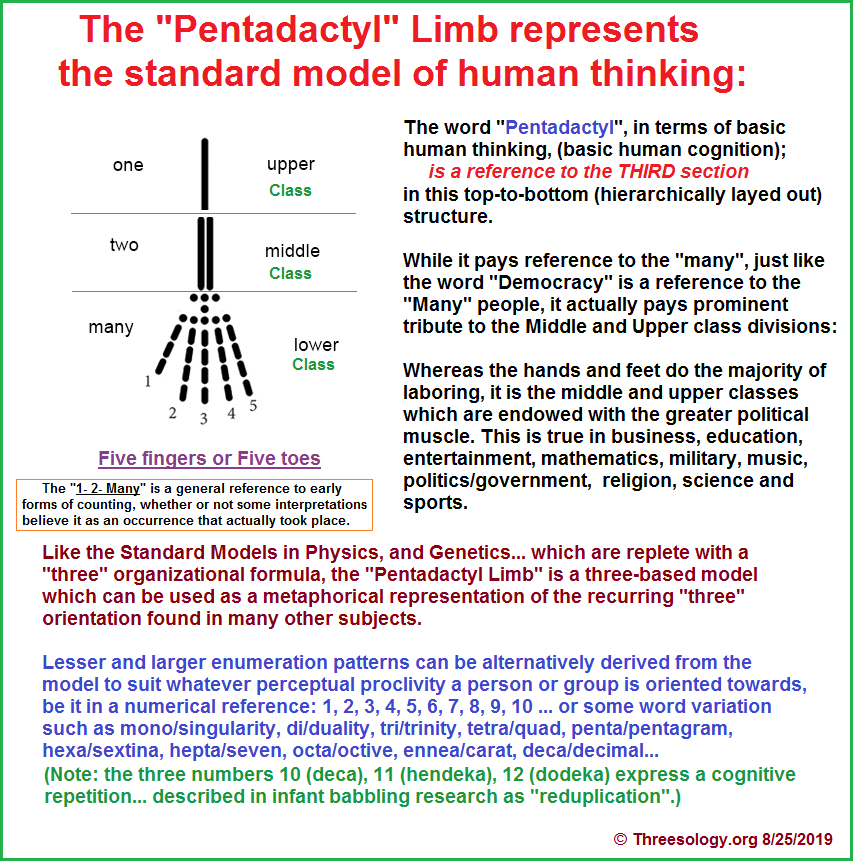
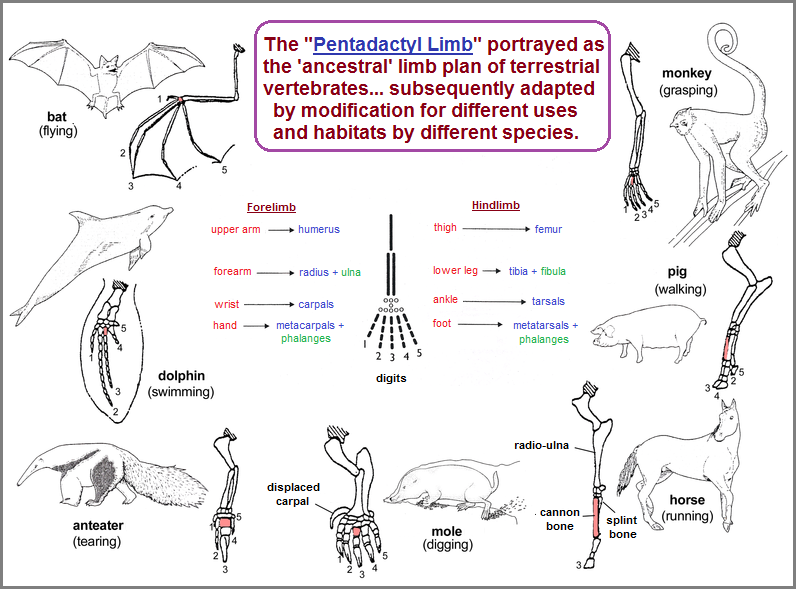
Language. Ah yes, language. From the babbling of a brook into streams of thought from which we are provides an ocean of knowledge. With secret words, into an uncompleted tower of Babel from which incantations spill forth in an attempt to conjure up that thought to be summoned to do our bidding for good or evil. Thus too do we envision language in the frame of a personal name that when known provides us with power over someone; as an idea summarized in the story of Rumplestiltskin. Whereby if not by an incantated phrase then the repetition of a single word is sometimes used to set the stage for a desired scenery that is often vaguely described with attendant beliefs associated with an indulged mood such as in the case of a Mantra, for which the two-lettered "Om" can be referenced as a condensed representation of the three letters AUM.
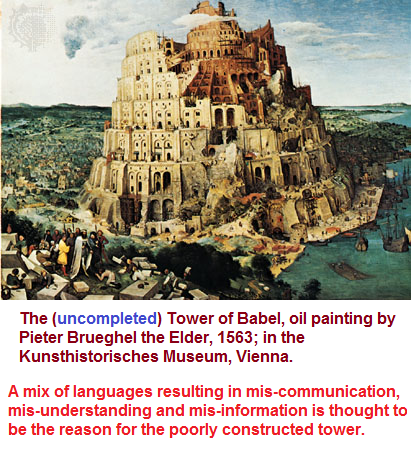 |
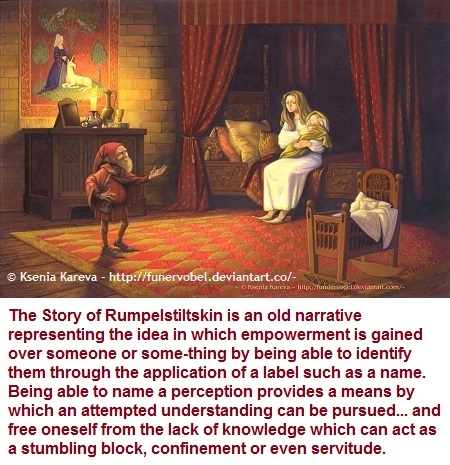 |
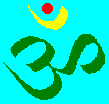
Om, in Hinduism and other religions chiefly of India, a sacred syllable that is considered to be the greatest of all the mantras, or sacred formulas. The symbol Om is composed of the three sounds a-u-m (in Sanskrit, the vowels a and u coalesce to become o), which represent several important triads: the three worlds of earth, atmosphere, and heaven; the three major Hindu gods, Brahma, Vishnu, and Siva; and the three sacred Vedic scriptures, Rg, Yajur, and Soma. Thus Om mystically embodies the essence of the entire universe. It is uttered at the beginning and end of Hindu prayers, chants, and meditations and is freely used in Buddhist and Jaina ritual also. From the 6th century, the written symbol designating the sound is used to mark the beginning of a text in a manuscript or an inscription. The syllable is discussed in a number of the Upanishads, which are the texts of philosophical speculation, and it forms the entire subject matter of one, the Mandukya. It is used in the practice of Yoga and is related to techniques of auditory meditation. In the Puranas the syllable is put to sectarian use; thus the Saiva mark the lingam, or sign of Siva, with the symbol for Om, whereas the Vaishnava identify the three sounds as referring to a trinity composed of Vishnu, his wife Sri, and the worshipper. (Source: Buckland's Third Revolution Poster column # 6)
What may be described as a variant of the mantra connected with sacred texts is the notion of "Sutra" (Sanskrit: "thread" or "string", Pali: sutta ):
In Hinduism, a (sutra is a) brief aphoristic composition; in Buddhism, a more extended exposition, the basic form of the scriptures of both the Theravada (Way of Elders) and Mahayana (Greater Vehicle) traditions. The early Indian philosophers did not work with written texts and later often disdained the use of them; thus, there was a need for explanatory works of the utmost brevity that could be committed to memory. The earliest sutras were expositions of ritual procedures, but their use spread. The grammatical sutras by the Sanskrit grammatician Panini (6th–5th century BCE) became in many respects a model for later compositions. All the systems of Indian philosophy (except the Samkhya, which had its karikas, or doctrinal verses) had their own sutras, most of which were preserved in writing early in the Common Era.
Different from its usages in Hindu literature, the Buddhist sutra (Pali: sutta) denotes a doctrinal work, sometimes of considerable length, in which a particular point of doctrine is propounded and deliberated. The most important collection of the Theravada sutras is to be found in the Sutta Pitaka section of the Pali canon (Tipitaka, or "Triple Basket"), which contains the discourses attributed to the historical Buddha. In Mahayana Buddhism the name sutra is applied to expository texts.
"sutra." Encyclopædia Britannica Ultimate Reference Suite, 2013. (Britannica.com: Sutra)
With respect to the secret language of once practiced by mystics, though shamans, witch doctors, high priests, seers, and their ilk all have their respective jargoning approaches used to evoke a super-natural repository of significance variously named insight, future-sight, ancient knowledge, intuition, creativity, genius, etc.; let us take a look at a short reference regarding mysticism and its counterparts such as psychoanalysis, all of which are focused on some specialized language attended by specialized behaviors, thus the behavior can be seen as either a language and/or a punctuation. Both good and bad behaviors are thus enabled to be seen as good and bad language that may be communicated into bad deeds that interrupt one's attempts to achieve a purity, be it called truth, bliss, enlightenment, atonement, rebirth, transcendence, or otherwise.
What mystics hope to achieve differs from culture to culture. Shamans, theurgists, Daoists, Kabbalists, Western esotericians, and many others are primarily interested in mystical experiences as a means of performing magic. The gnostics of late antiquity, Hindu mystics, and Buddhists have sought liberation from ignorance through the apprehension of truth, and Christian and Sufi mystics seek consolation in God.
For the most part, mystics are engaged in acquiring a set of skills that will enable them to have visions, unitive experiences, possession states, and so forth. In a few cases, however, the purpose of mystical practice is to produce personal transformation. Confucianism, for example, is aimed at the cultivation of sagehood. Fourteenth-century Roman Catholic meditations on the Passion of Christ, which induced death-and-resurrection experiences that were considered mystical unions with Jesus, were consciously aimed at reforming the soul in both faith and feeling. Early English Methodism was aimed at the achievement of a state of "sanctification," in which sin ceases to be tempting and virtue is effortless. Tibetan Buddhism is directed toward the production of enlightened individuals, called bodhisattvas, who inevitably acquire compassion as a side effect of their progress toward truthful understanding.
Modern psychological research has established that both Buddhist "insight" meditation and Jesuit spirituality, the latter based on the teachings of St. Ignatius of Loyola, promote healthy growth of the personality. Other researchers, however, have argued that mystical practices can be used as a form of brainwashing that promotes cult behaviour. Brainwashing typically involves a blend of attraction and coercion that subverts a person's sense of integrity and inculcates a new set of values. Positive techniques such as support from the in-group coincide with negative techniques such as shaming, guilt-making, physical abuse, and isolation from friends, family, and other outsiders. In such a context, the euphoria of mystical experience may enhance the attractiveness of a cult. It is not the positive techniques, however, but only the negative ones that reach traumatizing intensity, accomplishing coercion rather than persuasion. In all, mysticism may be regarded as an emotionally intense experience, in which the personality is unusually plastic. Change for both the good and bad is possible to a greater than usual extent.
In 1966 David Bakan, one of the founders of humanistic psychology, argued that Sigmund Freud's practice of psychoanalysis—and, by extension, all of the psychotherapies derived from it—constitute a modern revival of rational mysticism. Bakan contended that free association is a type of meditation that is intended to induce moments of inspiration that psychoanalysts call "insight." Psychoanalytic insights not only provide intuitive access to truths that are not manifest but also disclose a unity that underlies the apparent disconnectedness or non-integration of manifest thought. Whereas the Aristotelian mystics of antiquity and the Middle Ages meditated on nature outside themselves, Freudian clients meditate on their own natures, arriving at results that are no less mystical. In keeping with Bakan's intuition, several initiatives have sought to coordinate traditional religious mysticism with contemporary psychotherapy.
For example, transpersonal psychology, which developed from humanistic psychology in the 1970s, proceeds from the assumption that, because some mystics have demonstrably enjoyed superlative mental health, selected uses of classical mystical techniques may facilitate the therapeutic goal of self-actualization. Westerners who engage in Buddhist forms of meditation have frequently attempted to use them as a kind of self-therapy, leading meditators who are qualified psychotherapists to place programs of meditation on a professionally responsible foundation. Within Freudian psychoanalysis, a very small number of practitioners have recognized both free association and the analyst's practice of "analytic listening" as types of meditation and have attempted to articulate further the mystical character of psychoanalysis. At the same time, many of the world's religions are becoming massively psychologized. Religious counseling and pastoral work are everywhere becoming increasingly sophisticated in both psychotherapeutic competence and psychological understanding. If deep psychotherapy is indeed a rational form of mysticism, then a new era in mysticism worldwide could be at hand.
Dan Merkur: Psychoanalyst and Research Reader in the Department of the Study of Religion, University of Toronto. Author of The Psychedelic Sacrament: Manna, Meditation, and Mystical Experience and Mystical Moments and Unitive Thinking.
"mysticism." Encyclopædia Britannica Ultimate Reference Suite, 2013. (Britannica.com: Mysticism )
The "power" of charismatic individuals is a reference to a type of "behaviored language"... that is, language that has achieved a behavior of being able to create imagery that may either act as an attractive or repulsive magnet. For some, such as myself, they are able to sit with a dictionary or a simple list of words which supply the context for creating one or more images that can be dwelled upon or even elaborated on to the point of creating an enlarged attachment of characters and situations. Training oneself not to be moved by a word or phrase enables them to withstand the persuasiveness which often accompanies "behaviored language".
Meditation is another dimension of language which frequently consists of a repetitive monologue, though one need not use internally intonated language to create a trance-like state of self-absorption which excludes other externalities of influence.
(Meditation is) private devotion or mental exercise encompassing various techniques of concentration, contemplation, and abstraction, regarded as conducive to heightened spiritual awareness or somatic calm. Meditation has been practiced throughout history by adherents of all the world's religions. In Roman Catholicism, for example, meditation consists of active, voluntary, and systematic thinking about a biblical or theological topic. Mental images are cultivated and efforts are made to empathize with God or with figures from the Bible. Eastern religious practices that involve thinking in a controlled manner have been described as meditation in the West since the 19th century. The Hindu philosophical school of Yoga, for example, prescribes a highly elaborate process for the purification of body, mind, and soul. One aspect of Yoga practice, dhyana (Sanskrit: "concentrated meditation"), became the focus of the Buddhist school known as Chan in China and later as Zen in Japan. In the late 1960s the British rock group the Beatles sparked a vogue in the West for Hindu forms of meditation, and in the following decade Transcendental Meditation (TM) became the first of a variety of commercially successful South and East Asian meditative techniques imported by the West. Academic psychological studies of TM and other forms of meditation followed rapidly.
In numerous religions, spiritual purification may be sought through the verbal or mental repetition of a prescribed efficacious syllable, word, or text (e.g., the Hindu and Buddhist mantra, the Islamic dhikr, and the Eastern Christian Jesus Prayer). The focusing of attention upon a visual image (e.g., a flower or a distant mountain) is a common technique in informal contemplative practice and has been formalized in several traditions. Tibetan Buddhists, for example, regard the mandala (Sanskrit: "circle") diagram as a collection point of universal forces, accessible to humans by meditation. Tactile and mechanical devices, such as the rosary and the prayer wheel, along with music, play a highly ritualized role in many contemplative traditions.
Most meditative practices concentrate attention in order to induce mystical experiences. Others are mindful of the mental character of all contents of consciousness and utilize this insight to detach the practitioner either from all thoughts or from a selected group of thoughts—e.g., the ego (Buddhism) or the attractiveness of sin (Christianity). Meditation may also serve as a special, potent preparation for a physically demanding or otherwise strenuous activity, as in the case of the warrior before battle or the musician before performance.
Although the primary purpose of meditation is the realization of truth, the doctrinal and experiential truths claimed by different practices of meditation are often inconsistent with each other. Hinduism, for example, asserts that the self is divine, while other traditions claim that God alone exists (Sufism), that God is immediately present to the soul (Christianity and Judaism), and that all things are empty (Mahayana Buddhism).
In the West, scientific research on meditation from the 1970s focused on psychological and psychosomatic illnesses. Meditative techniques used by skilled practitioners proved to be effective in controlling pulse and respiratory rates and in alleviating symptoms of migraine headache, hypertension, and hemophilia, among other conditions.
Disenchantment with materialistic values led to an awakening of interest in Indian, Chinese, and Japanese philosophy and practice among primarily young people in many Western countries in the 1960s and '70s. The teaching and practice of numerous techniques of meditation, most based on Asian religious traditions, became a widespread phenomenon. For example, the practice of "mindfulness meditation," an adaptation of Buddhist techniques, was popularized in the United States beginning in the 1980s. Its medical use as an adjunct to psychotherapy was widely embraced in the late 1990s, leading to its adoption in many psychiatric facilities.
Dan Merkur
"meditation." Encyclopædia Britannica Ultimate Reference Suite, 2013. (Britannica.com: Meditation)
From this setting we might then want to venture the question of when language in humans began. Did it begin in a non-verbal mode of expression such as flinging arms about? Was this then followed by grunts, hoots, howls, snortss, and the like such as is displayed in not only primates but other large animals as well? But let us leave this channel of speculation and move on more so to the usage of language by humans that became more developed, yet in the context to which the presence of language became identified as something unique, necessarily so it was defined within the context of religion, as we find in the Biblical reference of John 1:1 which states that In the beginning was the word, The word was with god and the word was god., thus representing it as a type of canonical law:
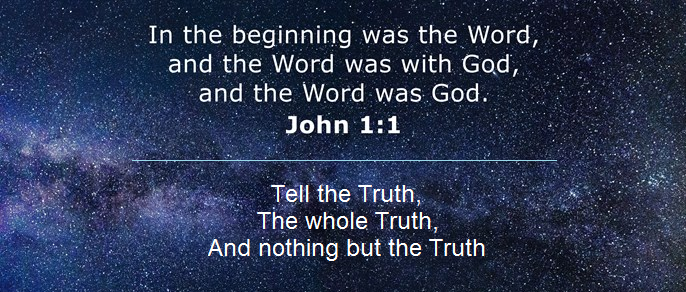
The second or bottom three-part phrase used in the secular legal system gives me the impression of the same underlying formula and intent involving an orientation interested in conveying a truth to be observed. Like a string of matched pearls or sequential system of numbers, the lines inter-mesh in both instances like a syllogism referencing a "major premise- minor premise- conclusion" formula.
Language in ancient times, particularly upon its acknowledged emergence and interpretation of being from an other-worldly existence; gives us an indication of its importance in human affairs, at least in the context of where, when and with whom this three-patterned idea arose in history. Taking it out of the religious context does not demean the value of language, but gives a clearer picture of it as an emerged behavior with a before-and-after time frame for the sake of studying language. The same can be said for the three-patterned oath applied to a legal system in that though its exact date of originating is a bit murky, it nonetheless provides us with a clue as to how and when the human cognitive process became more imbedded with a usage of language as the primary form of gestural expression.
The tradition of requiring witnesses to swear an honesty oath likely traces back to Roman times. Urban legend contends that male Romans had to squeeze their testicles while vowing to tell the truth, which is why the Latin word for witness is testis. Latin scholars have debunked this colorful claim, pointing out that testis more likely comes from the Ancient Greek for "three"—a witness being a third observer of events. Still, the orator Cicero alluded to the importance of legally binding oaths in De Officiis, and the Law of the Twelve Tables, the earliest of codification of Roman law, stresses that perjurers "shall be hurled down from the Tarpeian Rock." (The origin of the truth, the whole truth, and nothing but the truth. by Brendan Koerner, April 30, 2004).
The "Standard Cognitive Model" image can be metaphorically described as three rocks with a prominent 3-patterned mark, albeit the marks are portrayed in a different way as if three different artists etched out some reference in the vernacular which they are inclined to use. Although the illustration is itself a metaphor of three different orientations being inter-related to describe an underlying similarity, we are thus confronted by the use of a metaphor to describe a metaphor that I consider to be the description of yet another metaphor which requires us to look at language.
However, before even beginning let me reference a few philosophical considerations such as whether or not Language is a prerequisite for consciousness. In other words, must a language be present before consciousness is attained or does consciousness exist prior to language acquisition and that once a language is acquired it merely references different representations of perception in crude ways that multiple people come to adopt as the best representation of an assumed truth? What then is the "Mother Tongue" of pristine, pre-language consciousness, and is this form of consciousness the purest form of perception from which can be derived a clearer picture of reality that human physiology is capable of perceiving and making sense of within the realm of human sensory capability?
What then do we make of those perceptions which are accentuated with instrumentation which assists in making human types of sensory channels become more acute (hearing aids, telescopes, microscopes, stethoscopes, etc...), that is, more finely tuned or made less tuned, such as when one removes their glasses to perceive the world with a distorted vision, although that perceived allows for a different sense from which can be derived a reality that we can be advantaged by? For example, the lack of one or more routine human senses can create a situation whereby some compensation takes place to offset the loss or lack of, in that another sense becomes more acute and is interpreted to be a gift or extra-sensory ability. What then do we make of those whose ideas appear to exhibit an extra-sensory ability (or at least capability even if they don't exercise it) but we label it a greater intelligence, wisdom or insight? Have such people acquired knowledge of one or another type/kind of "mother tongue" that is a language which provides a greater level... a clearer picture of some supposed truth? Yet, how so often it comes to be realized that conventional or unconventional language, jargon, idioms, etc., tend to get in the way of discerning a greater clarity, much less providing a means for illustration. Whereas many turn to mathematics, other to music, some to art, etc... none of these are THE mother tongue, unless we are to assume that any such mother tongue can not speak for itself and requires some biological mouth piece.
If language can be defined as being other than words, other than emitted sounds, is their a single form and does it exhibit three-based formula? Can we not view the existence of atomic particles and their as yet unclear, underlying formulaic structure currently labeled the Standard Model, as a type of language that may appear to be mute, but actually has a language which can speak for itself but that human language interrupts and drowns it out with it currencies of repetitions that act as monotonous mantras which numb human consciousness into a narcolepttc state labeled normal reality? If the recurring presence of patterns of three is a coincidence or a fluke, why not some other enumerated pattern? Does the recurrence of "three" in so many subjects illustrate some Universality or simply the Universe of human biological activity under incrementally deteriorating circumstances?
If we say the language— structure of atomic particle physics is older than astronomy which is older than geology which is older than genetics which is older than biology which is older than physiology which is older than human vocal tract language, then do we have a lineage of language(s)? Unless we want to describe particle physics as existing in a world in which there exists an internalized astronomy, geology, etc... If the "shell" model of particle physics is to be used as a description that resembles a solar system configuration akin to an old pin ball machine game with a slanted (non-level) field of play where the particles are subjected to a gravitational inclination resembling the vortex of a turbine engine where speed-of-light (converted enthalpic mirror-imaged 'reflections/refractions/absorptions' of fluidic, mechanical, thermal, electric) velocities are reached by way of successive attributions which illustrate the relationship between electromagnetism and gravity; is this not an internalized Astronomy and is this Astronomy not made possible by the assumed "geology" of the particles whose physical properties on their respective internalized scales are viewed in terms of waves and wavelets similar to the illiterate perceptions of those in an ancient age that a person seen walking in a desert under a hot sun was thought to be walking on water and thus deified as some sort of super-ordinary occurrence?
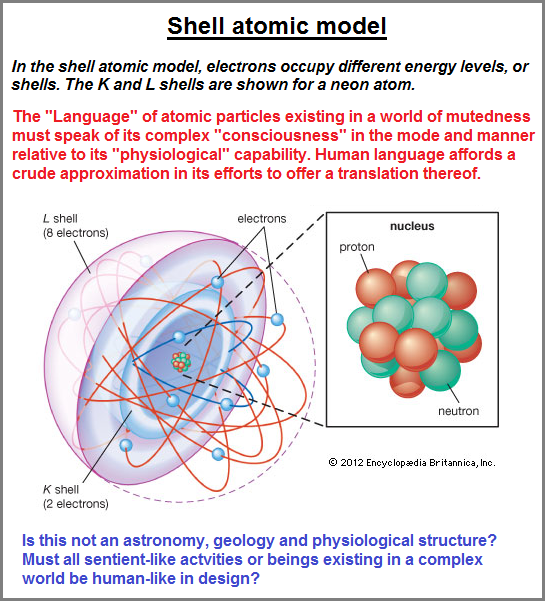
In far too many instances we impose a present day (modern) language of old ideas on an ancient system— an ancient construction— an ancient structure; and yet are unable to create that system, construction, structure. For example: the ancient Egyptian pyramids. Our modern language using old ideas does not provide us with an adept knowledge of hot to actually build a pyramid, even with modern equipment. Hence, modern language is not a/the mother tongue by which all languages can best be interpreted, much less create a duplicate derivative in order to place our consciousness on a similar "wave-length" of the old orientations. If language is not a prerequisite of consciousness, but affords us with but variations or variations of expressing one or more types/kinds of consciousness, there is there a language which encapsulated all without resorting to a crude vernacular such that we create belief systems whose vernaculars are a mere jargon that develops an idiom as indicated by the word "god"?
Interestingly, there are some Linguists and others who view the study of Language as a sort of Mother Tongue which enables them to perceive, analyze and illustrate fundamentals in a similarity of preoccupation we find with other subjects such as Mathematicians viewing themselves as those possessing The or A mother tongue by which reality is best perceived in fundamental terms. So to do physicists, musicians, artists, poets, biologists, chemists and others who share an interest into delving the presumed repository of some assumed chamber of fundamentals. Hence, it is perhaps better to approach the discussion from the vantage point that all subjects are merely jargons, dialects, accents, etc., of an assumed existing mother tongue. Language is therefore not a Mother Tongue, but some vague representation thereof, as are all subjects, thereby requiring us to utilize as many as we can in order to identify recurring patterns consistent with all of them.
Interestingly, when we take a reflection of what language provides us with, we might sum it up as follows:
What has been established is an elaborate means of convincing oneself and others against the contention of opposition, from which is established a conviction that produces a confession to promote the elaboration as a belief. Different views (actual or in word only) as artefacts, are assembled in a way to create a lineage of favorable impressions used to affirm a supposition into becoming a belief that is promoted as proof; yet nothing but how elaborate humanity is in convincing itself has been that which is proven. Such commentary is succinctly represented by defining the University degrees denoted as B.S., MS, and PhD as Bull shit, More of the same, piled higher and deeper. And yet how many of those reading this have recognized yet another pattern-of-three being used by human consciousness as part of a Standard Cognitive Model?
In as much as you may think of a library full of books as a repository of various types of intelligence and knowledge using language as the primary means of description; I see a library's collection of books as collections of etched rocks displayed in piles. If the word "rocks" appears to be too crude, one might interchange the image with seashells, coins, kites, plates, etc., all of which frequently bears some mark of the maker... or in this case, the author(s). They are piles of rocks sorted into other piles arranged by the three-patterned system of author-title-subject, supported by a mathematical referencing call the Dewey Decimal system. The three-patterned author- title- subject is like a primitive's etched scratches on a stone.
If we look upon language as a falsely viewed requirement for consciousness, then the three patterned "language" of atomic particles is a much older tongue than is human vocalization. So too is the three-patterned genetic code. They are more fundamental languages which exhibit a similar pattern of organization. So too does the third placement of the Earth in the solar system. If these recurring expressions are not the revelation of some Universal language code, then they are a code simply representing an imposition of human perception on multiple instances. This would thus mean that human physiology has been imposed upon by the environment to exhibit a similar orientation as per a requirement for equilibrium. Why else the consistency? If a pattern of three structure is not inherent in multiple perceptions of different objects, then it must be the result of an artificialized imposition created by human perception to fulfill some need. If we claim an existence for the idea of evolution, is this reserved only for biology, or can inanimate objects evolve as well? Whereas we might not use the word "evolution" since it has been relegated to the singular stage performance of biology, this does not mean the word alteration or change over time can not be applied.
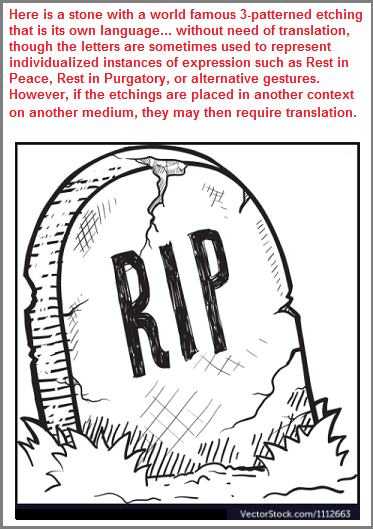 |
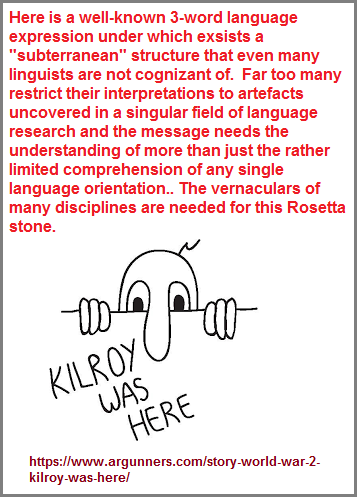 |
Date of Origination: Saturday, 14th March 2020... 6:11 AM
Date of Initial Posting: Sunday, 10 May 2020... 8:59 AM
Updated Posting: Sunday, 1tth May, 2020... 8:30 AM